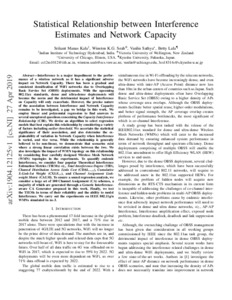Kala, Srikant Manas and Seah, Winston K G and Vanlin Sathya, R and Lala, Betty
(2019)
Statistical Relationship between Interference Estimates and Network Capacity.
arXiv.
![[img]](http://raiithold.iith.ac.in/5058/2.hassmallThumbnailVersion/Statistical%20Relationship%20between%20Interference%20Estimates%20and%20Network%20Capacity.pdf)  Preview |
|
Text
Statistical Relationship between Interference Estimates and Network Capacity.pdf
Download (623kB)
| Preview
|
Abstract
Interference is a major impediment to the performance of a wireless network as it has a significant adverse impact on Network Capacity. There has been a gradual and consistent densification of WiFi networks due to Overlapping Basic Service Set (OBSS) deployments. With the upcoming 802.11ax standards, dense and ultra-dense deployments will become the norm and the detrimental impact of Interference on Capacity will only exacerbate. However, the precise nature of the association between Interference and Network Capacity remains to be investigated, a gap we bridge in this work. We employ linear and polynomial regression to find answers to several unexplored questions concerning the Capacity Interference Relationship (CIR). We devise an algorithm to select regression models that best explain this relationship by considering a variety of factors including outlier threshold. We ascertain the statistical significance of their association, and also determine the explainability of variation in Network Capacity when Interference is varied, and vice versa. While the relationship is generally believed to be non-linear, we demonstrate that scenarios exist where a strong linear correlation exists between the two. We also investigate the impact of WMN topology on this relationship by considering four carefully designed Wireless Mesh Network (WMN) topologies in the experiments. To quantify endemic Interference, we consider four popular Theoretical Interference Estimation Metrics (TIEMs) viz., TID, CDALcost, CXLSwt, and CALM. To ensure a sound regression analysis, we consider a large set of 100 Channel Assignment (CA) schemes, a majority of which are generated through a Generic Interference aware CA Generator proposed in this work. Finally, we test the TIEMs in terms of their reliability and the ability to model Interference. We carry out the experiments on IEEE 802.11g/n WMNs simulated in ns-3.
Actions (login required)
 |
View Item |


 Altmetric
Altmetric Altmetric
Altmetric